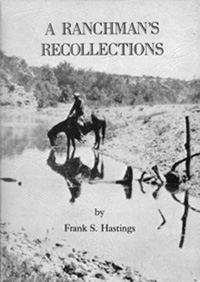
There were no blueprints for breeding cow horses 100 years ago – no magic crosses or pedigree nicks – just a need for tough “ponies” to fill ranch remudas.
“A large number of Texas cow outfits have had their notions about cow-pony crosses…but in the main, cow horse breeding has been a pure case of “scrambled eggs,” noted Frank S. Hastings in his classic A Ranchman’s Recollections, first published in 1920, as a series of articles for the Breeder’s Gazette.
Hastings had worked as meat broker and Hereford herd manager for the Armour Company before he became manager of Texas’ famous SMS Ranches in 1902.
Founded by Swante “Sven” Swenson in 1854, by the early 1900s, SMS Ranches ran 25,000 cattle on 350,000 acres. It was Hastings who pioneered a large-scale 5,000-head feeding operation in Stamford, Texas, where cattle were fattened on cottonseed meal and molasses.
In A Ranchman’s Recollections, Hastings recalls that in 1902, the SMS, sold a surplus of 200 mares for $7.50 a head. The herd traced to 50 Spanish mares purchased in 1882, as the original SMS breeding band.
“Spanish horses, as I understand them, were a pure Mexican breed – small, mean, tough, quick as a cat, and had all the ‘cow instinct…practically no producer of cow horses, however, appears to have been satisfied with to stay with the Spanish blood in its purity,” Hastings wrote. “Probably meanness had much to do with the popular desire to breed the strain up without losing the cow instinct.”
Intent on breeding “the strain up,” the SMS acquired an Arabian stallion. Several “Missouri saddle horses,” as well as a Saddlebred and a Thoroughbred stallion were then used  on the Arabian’s daughters. Later, several grade Percherons and Clydsdales from Spanish mares and a German coach horse were added to the mix.
Nine registered Morgan stallions were acquired during Hasting’s tenure (from 1902 until his death in 1922). By 1920, the SMS Ranches horse herd totaled 1,100 head for all purposes, with 500 used specifically for cattle work on 400,000 acres.
Cow horses were broken in the spring of their 3-year-old year and served  an average of 12 years, although it was not unusual for cutting horses to work until they were 18 or 20 years old.
Hastings mentions that the rage for polo ponies threatened to drain Texas cutting horse stock in the early 1900s, and the U.S. Army’s demand for horses in World War I depleted supplies of young cowboy stock.
Ninety years ago, when a Model T Ford cost $290, Hastings noted that there were “more buyers for a $300 cow horse than there are horses good enough to realize that price or owners willing to sell.”
A Ranchman’s Recollections, which includes some great Frank Reeves photos, is available here
.
